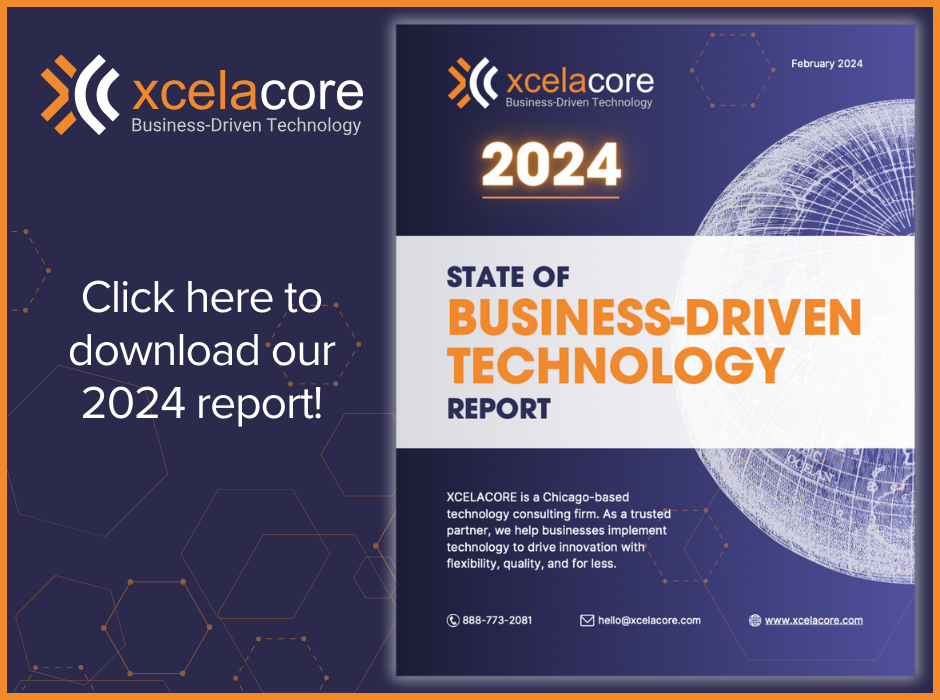Our 2024 State of Business-Driven Technology Report gathers valuable insights from technology leaders across industries. Our findings made it even clearer that AI (Artificial Intelligence) is not just the buzzword of the moment but a top priority for organizations as they move to leverage and budget for new technologies. 72% of business technology leaders reported that artificial intelligence and machine learning are the top technologies they see impacting their business in the next five years.
Why AI?
According to McKinsey & Co., 60% of companies with reported AI adoption are using generative AI to help automate business processes, accelerate value-added efficiencies within client work, analyze data and trends, and improve overall organizational performance. AI is a gold mine when it comes to streamlining operations, unlocking valuable data, and driving revenue for businesses in all industries.
Where are we seeing AI have the most impact right now?
Web technologies, including e-commerce, CRM, and digital payments, ranked high for impact in the coming years. According to Statista, global e-commerce spending reached $5.8 trillion in 2023. This represents a significant growth in online retail sales worldwide. In e-commerce innovation, AI is a powerful tool for hyper-personalization. By assessing large datasets, AI can be used to make predictive shopping recommendations that make for a more dynamic and enjoyable customer experience.
Data analytics, powered by AI, will become a more critical strategic component within organizations. AI has the power to quickly assess large amounts of data and then draw conclusions, insights, and themes from said data. For example, AI can be leveraged to sift through customer reviews or testimonials and then provide insights into what products or features customers are satisfied with and identify where there is room for improvement.
Automation, including robotics, streamlines operational efficiency and helps businesses provide more efficient service and personalized customer experiences. Hyperautomation combines the powers of RPA, AI, and machine learning to automate and optimize business processes. RPA (Robotic Process Automation) automates repetitive, rule-based tasks, reducing errors and improving the speed of various business processes. Gartner predicts that by 2024, organizations will lower operational costs by 30% through a combination of hyperautomation technologies. We’re also seeing a growing emphasis on automated testing processes to ensure the quality and reliability of software and business applications, enhancing overall product integrity. Automating QA Testing allows businesses to complete the testing cycle in hours instead of days, freeing up valuable company resources.
Organizations are increasing cybersecurity investments to protect sensitive data and maintain customer trust. According to IDC’s Worldwide Semiannual Security Spending Guide, worldwide spending on security products and services is forecasted to reach nearly $300 billion by 2026, indicating a significant focus on safeguarding sensitive data. Cloud security is a priority, with measures like access controls, encryption, and testing/monitoring. AI can be leveraged to identify and respond to security threats, scan for vulnerabilities and weaknesses, and learn and evolve in real-time based on known threats.
Barriers To AI Adoption
Although the latest innovations in AI seem to offer unlimited benefits, implementing and adopting this new technology is not without challenges. For many organizations, there are very real barriers to leaning into this new age of AI.
AI models need high-quality data and adequate data management systems in order to run and function efficiently. Many organizations lack clean, quality datasets, and the effort to clean and consolidate said data may seem like an insurmountable task.
When it comes to the complexities of AI, some organizations may find that they lack adequate expertise and understanding within their organization. With the rapid development and quick-moving nature of AI innovation and trends, it can be difficult to keep up.
For many organizations, the biggest barrier may be one of sentiment. Resistance to change and fear of the unknown can prevent both employees and leaders of a business from seeing the upside to overhauling antiquated, legacy systems and learning new technology.
Seeking help from third-party consultants can be a great solution for each of these barriers. Expert technology consultants, like our team at Xcelacore, can take on data quality issues, offer unmatched industry expertise, and help teams see the benefits of adapting to new technology.
AI isn’t the only technology on the minds of business leaders. Download our full report for more key technology takeaways and compelling insights into decision-making at the intersection of business and technology.

